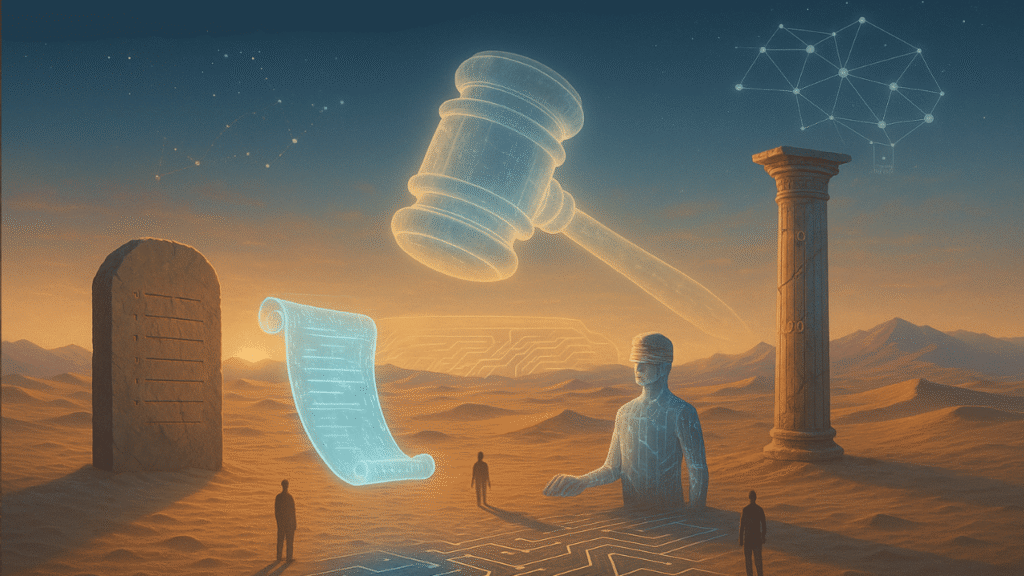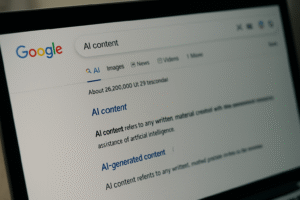Legal work has always required precision, consistency, and deep critical thinking. But the rise in case volume, document complexity, and client expectations has pushed law firms to rethink how they manage time-consuming tasks like research, contract review, and administrative work. That’s where technology—especially AI—has begun to prove its value.
AI legal services aren’t a futuristic promise. They’re already here, quietly working behind the scenes in firms of all sizes. From scanning thousands of pages in seconds to highlighting risky clauses in contracts, these tools are reshaping how legal teams approach their day-to-day operations without touching the core of legal reasoning and judgment.
What makes this shift different is how AI is reinforcing human expertise—not replacing it. Lawyers remain in control, but now they’re backed by systems that help them work faster, catch more errors, and serve clients with greater accuracy. The result? A legal practice that’s not just more efficient, but more reliable.
What Are AI Legal Services?
AI legal services refer to purpose-built technologies that assist legal professionals by streamlining tasks that are repetitive, time-consuming, or data-heavy.
These tools are not general-purpose AI platforms retrofitted for legal use—they are trained on legal language, designed to follow legal standards, and built to complement legal workflows.
Whether it’s analyzing dense contracts, pulling relevant case law in seconds, or automating billing and scheduling, AI is making law firm operations more efficient without compromising quality or compliance.
Definition and Scope
AI legal services cover a wide range of applications. At their core, these tools use natural language processing (NLP), machine learning, and data analytics to interpret legal text, detect patterns, and perform actions that would otherwise require hours of manual labor.
For example, some platforms are built to assist in legal research by parsing case law databases and surfacing relevant citations. Others specialize in contract review, helping firms detect risky language or missing clauses in seconds. There are even AI-powered platforms for e-discovery, billing automation, and client intake.
These tools can be offered as standalone products or integrated into case management systems already in use. Importantly, their value isn’t just in the automation—they offer insights that help legal teams make faster and more informed decisions, especially when working under pressure.
The Human-AI Partnership in Law
Despite their growing capabilities, AI tools are not substitutes for legal professionals. They can process information faster and with greater consistency, but they lack the ability to interpret context, exercise judgment, or ethically weigh the nuances of a case. That’s where human expertise remains essential.
The role of lawyers is not diminished—it’s refocused. Attorneys are moving away from low-value, repetitive tasks and toward higher-value strategic work, such as interpreting legal implications, negotiating outcomes, and advising clients.
AI tools serve as accelerators, giving legal teams more time and mental bandwidth to focus on the parts of the job that truly require a human mind.
How AI Is Transforming Legal Research
Legal research has always been one of the most labor-intensive aspects of practicing law. Sifting through decades of case law, statutes, and regulatory commentary can take hours—sometimes days—of focused effort. AI is changing that.
With tools designed to analyze and contextualize legal documents in seconds, legal research AI is helping firms reduce turnaround time without sacrificing quality. But speed is only part of the equation. Accuracy, relevance, and the ability to interpret findings still depend heavily on the lawyer using the tool.
From Hours to Seconds—The Power of Legal Research AI
Legal research AI tools use natural language processing and pattern recognition to scan thousands of legal documents quickly. They can identify relevant cases, cite precedents, and even summarize key arguments with surprising efficiency. Platforms like Lexis+ AI, Westlaw Edge, and CoCounsel Core are already in use across major firms, delivering search results that go beyond simple keyword matches by analyzing legal intent and context.
Instead of manually checking every possible angle, lawyers can enter a natural-language query and receive a curated set of resources—often ranked by legal significance. This cuts down hours of reading into a few minutes of critical evaluation.
Improving Accuracy and Reducing Risk
Aside from speed, one of AI’s biggest contributions is consistency. When a human paralegal or junior associate is tasked with research, results can vary depending on experience or fatigue. AI systems don’t suffer from those limitations. They comb through every relevant document without missing a citation or misinterpreting a statutory reference.
This consistency helps reduce the risk of oversight, especially in high-stakes litigation or regulatory cases where missing a key precedent could be costly. The more data the AI tool is trained on, the better it becomes at recognizing subtle legal nuances.
Why Lawyers Still Matter
Even with its efficiency, legal research AI isn’t a substitute for professional judgment. These tools can pull the data, but they can’t tell you what’s strategic, what’s persuasive, or what fits the client’s broader interests. That’s where the lawyer steps in—to filter, interpret, and apply the findings.
For instance, two cases might appear similar to an AI tool based on language patterns, but a lawyer might recognize jurisdictional nuances or procedural differences that change the entire legal strategy. AI does the heavy lifting, but the final call still belongs to the legal expert.
Smarter Contract Review with Contract Analysis AI
Contract review is one of the most repetitive—and risk-sensitive—tasks in legal work. Every clause, word, and punctuation mark can carry weight, especially in high-stakes deals. Traditionally, lawyers spend hours combing through agreements to catch inconsistencies, spot risks, and ensure nothing critical is overlooked. Contract analysis AI is designed to make this process faster and more consistent. While it doesn’t remove the need for human oversight, it drastically cuts down on time and increases accuracy across the board.
Automating the Tedious Without Sacrificing Precision
Contract analysis AI tools can scan and analyze hundreds of pages in seconds, flagging issues like missing clauses, deviations from standard language, and unusual risk terms. These tools are often trained on vast databases of prior contracts and case law, allowing them to identify patterns and recommend best practices based on industry norms or company policies.
Use cases include everything from NDAs and licensing agreements to complex M&A contracts. For example, tools like Kira Systems and LawGeex can automatically extract key terms, compare clauses against preferred templates, and highlight outliers—all before a lawyer even begins a detailed review.
Speed Meets Consistency
One of the biggest advantages of AI-driven contract analysis is consistency. When you’re working under pressure or reviewing similar documents repeatedly, it’s easy to miss minor discrepancies. AI doesn’t tire or lose focus, which makes it ideal for quality control.
In deal-heavy environments, where turnaround time is critical, these tools enable legal teams to move faster without sacrificing thoroughness. They’re especially helpful in compliance-heavy sectors, where contracts need to follow specific frameworks and timelines.
Where Human Review Still Reigns
While AI tools excel at surfacing issues, they don’t fully understand context, negotiation strategy, or client-specific goals. A clause flagged as “risky” by an AI system may be perfectly acceptable—or even advantageous—depending on the situation.
That’s why final reviews still belong to experienced attorneys. They provide the context, legal reasoning, and strategic input that machines can’t replicate. The AI flags the problem. The lawyer decides what to do about it.
Law Firm Automation: Streamlining Back-Office Workflows
While much of the attention goes to AI’s impact on legal research and contract review, a quieter revolution is happening behind the scenes. Law firms run on more than legal arguments—they rely on admin-heavy workflows that can be inefficient, error-prone, and time-consuming. From billing to client intake, AI-powered automation tools are helping law firms reclaim valuable time and reduce operational friction. These tools aren’t replacing legal knowledge—they’re removing the clutter that gets in its way.
AI-Powered Administrative Tools
Modern law firms are increasingly turning to AI for non-billable tasks like time tracking, invoicing, scheduling, and client onboarding. Tools like Clio and PracticePanther offer built-in automation for everything from sending appointment reminders to generating bills based on case activity.
AI chatbots are also becoming more common, handling initial client inquiries, screening for relevant case types, and even collecting basic intake information. This frees up staff and ensures potential clients don’t fall through the cracks while waiting for a human reply.
Workflow Optimization and Cost Savings
Administrative bloat is a common pain point in growing firms. AI helps address this by introducing smart workflows that reduce the need for repetitive data entry, follow-ups, and manual coordination. For example, integrated systems can automatically update calendars, assign follow-up tasks, or generate draft communications based on case status changes.
Over time, these efficiencies add up—not just in saved hours, but in cost reduction and improved client service. More importantly, they create room for legal professionals to spend time on tasks that actually require legal insight.
Balancing Efficiency with Compliance
Automation may improve productivity, but it also introduces new concerns. Law firms must ensure their automated systems are configured with compliance in mind—especially when it comes to data handling, client confidentiality, and record retention.
The best AI solutions offer audit trails, encryption, and access controls to meet regulatory and ethical standards. Still, lawyers need to remain involved in reviewing how these systems are set up and used. The goal is automation that complements, not compromises, professional responsibility.
Key Benefits of AI Legal Services for Modern Law Firms

The appeal of AI legal services isn’t theoretical—it’s practical. Law firms adopting these tools aren’t chasing trends. They’re responding to real challenges: limited time, growing caseloads, tight budgets, and rising client expectations. The right AI tools can help firms work faster, smarter, and with fewer errors. And while the benefits vary depending on use case, the core advantages are clear.
- Faster decision-making
AI accelerates processes that used to take hours—whether it’s legal research, document review, or admin tasks—giving lawyers more time to think, advise, and act. - Reduced operational costs
By automating repetitive work, firms can scale output without increasing overhead or adding unnecessary headcount. - Enhanced client service
Faster turnaround times, better accuracy, and smoother communication create a more responsive client experience. - Scalable legal insights
AI tools analyze vast data sets, making it easier to identify trends, spot risks, and support strategic decisions at scale. - Competitive advantage in tech-savvy markets
Firms that integrate AI effectively position themselves as more efficient, modern, and capable—qualities that clients increasingly expect.
Ethical, Regulatory, and Privacy Considerations
As AI tools become more embedded in legal workflows, firms must stay alert to the ethical and regulatory responsibilities that come with them. Legal practice is governed by strict rules—confidentiality, client consent, data protection, and professional conduct all apply, whether the work is done by a person or a machine. Using AI doesn’t reduce those obligations. It raises new questions about how to meet them.
Confidentiality and Data Protection
Legal work involves sensitive client information, often protected by attorney-client privilege. When AI tools are used to process that data, law firms must ensure that platforms meet stringent security standards. Encryption, access control, and secure data storage aren’t optional—they’re baseline requirements. Any tool handling client information must be vetted carefully to avoid breaches, leaks, or misuse.
Compliance with Bar Rules and Jurisdictional Laws
Different jurisdictions have different views on what constitutes the unauthorized practice of law. AI tools that offer suggestions or interpretations must be used under human supervision to avoid crossing ethical lines. Many bar associations are beginning to issue guidance on AI use, but it’s up to each firm to stay ahead of local and national regulations.
Beyond legal ethics, general data privacy laws—like GDPR, CCPA, or HIPAA (when applicable)—also come into play. AI tools must be assessed not only for what they can do, but how they handle, store, and transmit user and client data.
The Role of Explainable AI in Law
It’s not enough for AI to get the right answer—it must also show how it got there. “Black box” systems, where outputs can’t be traced or explained, raise red flags in a legal context. If an AI tool suggests a clause or flags a precedent, lawyers need to understand why. This is where explainable AI becomes crucial. Transparency isn’t just good practice—it’s an ethical necessity.
Choosing the Right AI Legal Services for Your Firm
Not all AI legal tools are created equal—and not every firm needs the same solution. Before investing in a platform, firms need clarity on what problems they’re trying to solve and what tools fit their existing workflows. The best AI tool isn’t the one with the most features. It’s the one that actually gets used, integrates smoothly, and improves daily operations without adding friction or risk.
Evaluate Your Use Case First
Start by identifying the gaps in your current process. Are attorneys losing hours to research? Are contract reviews slowing down deal cycles? Is administrative work draining your team? Pinpointing the need ensures you’re not paying for features you’ll never use—or ignoring areas where automation could create real value.
It also helps define the success criteria. What does improvement look like—faster turnaround? Fewer errors? Better client communication? These goals should shape your decision.
Key Features to Look For
Once you’ve defined the need, it’s easier to assess product fit. Look for tools that:
- Support your practice area (e.g., litigation, corporate, IP)
- Integrate with case management or billing systems you already use
- Offer customizable templates or workflows
- Provide user-level access control and audit trails
- Are backed by legal-specific training data, not generic models
Equally important: make sure the tool can scale with your growth and handle increasing document volume or team size.
Questions to Ask Vendors
Before you commit, ask the hard questions:
- How often is your AI model updated with legal developments?
- What jurisdictions or legal systems is it trained on?
- How is client data stored and protected?
- Can we audit the system’s decisions or suggestions?
- What onboarding and training do you offer?
Good vendors will have clear answers. If they don’t, that’s your answer.
What the Future Holds for AI in Law

AI’s role in the legal field is just getting started. What began as a way to speed up research or flag risky clauses is now evolving into more complex support systems—from predicting case outcomes to generating litigation strategies. But as capabilities grow, so does the responsibility to apply them wisely. The future of AI legal services won’t be defined by tech itself, but by how law firms choose to integrate it—with transparency, judgment, and a clear understanding of its limits.
AI-Assisted Litigation and Predictive Analytics
Some of the most forward-looking tools in development aim to assist with litigation strategy by analyzing outcomes based on past cases, judge behavior, and even jury tendencies. These predictive models are already in use for settlement planning and risk assessment in large-scale disputes.
While not a crystal ball, they help legal teams understand patterns and probabilities that would otherwise go unnoticed. Used carefully, they can sharpen strategies and improve decision-making.
The Evolving Role of Lawyers
As AI takes over repetitive legal tasks, lawyers are shifting into roles that emphasize human reasoning, client relationships, and ethical strategy. The work itself is changing—less about gathering information, more about applying it. Lawyers become interpreters, advisors, and decision-makers, relying on AI to handle the grunt work and surface insights that would take days to uncover manually.
This evolution doesn’t mean the end of traditional skills. It means those skills are being applied where they matter most.
Risks of Over-Reliance
Even the smartest AI has limits. Over-reliance can lead to blind spots, especially if firms stop verifying outputs or fail to question assumptions built into the tech. Legal professionals must stay involved at every step—reviewing, interpreting, and holding tools accountable.
No system is perfect. And in a field where lives, liberty, or major financial outcomes are on the line, due diligence can’t be delegated.
Final Thoughts
AI legal services are no longer experimental. They’re practical tools helping law firms work faster, smarter, and with fewer mistakes. From research to contract review to back-office workflows, AI is taking on the tasks that drain time and focus—giving lawyers more space to think, advise, and lead.
But the tech is only as useful as the people behind it. The firms seeing the biggest gains aren’t replacing their teams. They’re reinforcing them. AI handles the repetitive. Lawyers handle the complex. And that partnership is what defines the future of legal work—not disruption, but enhancement.
For law firms willing to adapt, AI isn’t a risk. It’s a resource. The challenge now is to adopt it thoughtfully—guided by need, backed by ethics, and driven by the same human expertise that’s always been at the heart of great legal practice.



